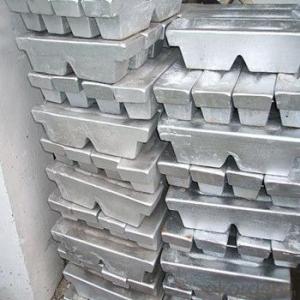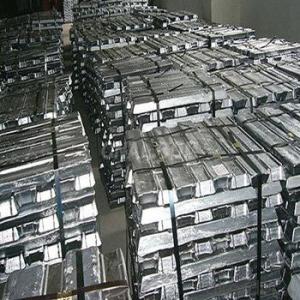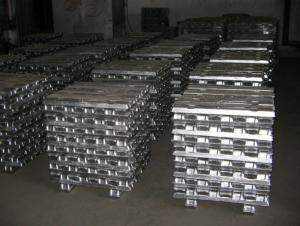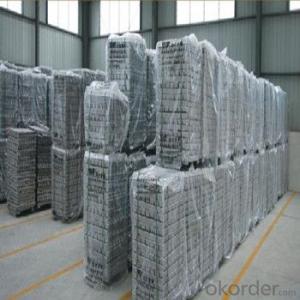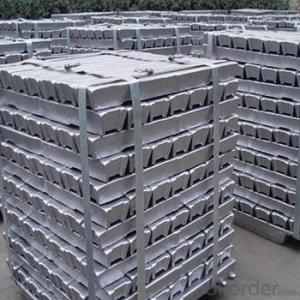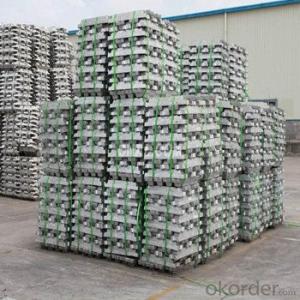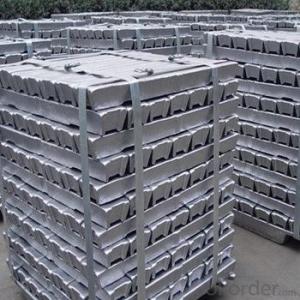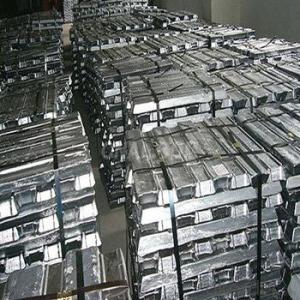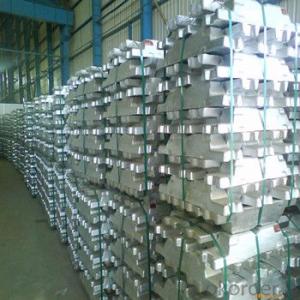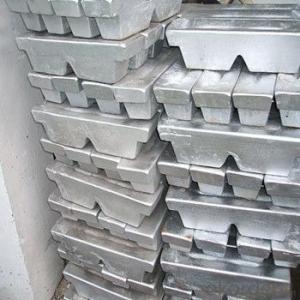Aluminium Ingots 99.7% Made By China Professional Manufacturer
- Loading Port:
- China main port
- Payment Terms:
- TT OR LC
- Min Order Qty:
- 1000 m.t
- Supply Capability:
- 10000 m.t/month
OKorder Service Pledge
OKorder Financial Service
You Might Also Like
Pure Aluminum Ingot Used for Industry
1.Structure of Aluminum Ingot Description
An ingot is a piece of material, usually metal, that is cast into a shape suitable for further processing. Insteelmaking, it is the first step among semi-finished casting products. Ingots usually require a second procedure of shaping, such as cold/hot working, cutting, or milling to produce a useful final product. Non-metallic and semiconductor materials prepared in bulk form may also be referred to as ingots, particularly when cast by mold based methods.
2.Main Features of the Aluminum Ingot
•High Purity
•High strength
•Fast melting
•Best price
•Good after-service
3. Aluminum Ingot Images
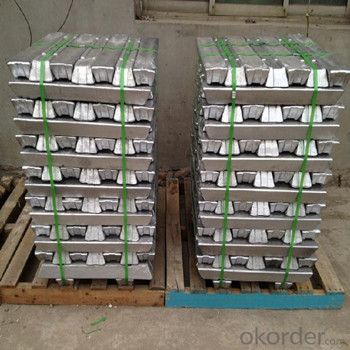

4. Aluminum Ingot Specification
Grade | Chemical Composition % | |||||||||
Al≥ | impurities ≤ | |||||||||
Si | Fe | Cu | Ga | Mg | Zn | Mn | others | Sum | ||
Al99.9 | 99.90 | 0.50 | 0.07 | 0.005 | 0.02 | 0.01 | 0.025 | - | 0.010 | 0.10 |
Al99.85 | 99.85 | 0.80 | 0.12 | 0.005 | 0.03 | 0.02 | 0.030 | - | 0.015 | 0.15 |
Al99.7 | 99.70 | 0.10 | 0.20 | 0.010 | 0.03 | 0.02 | 0.030 | - | 0.030 | 0.30 |
Al99.6 | 99.60 | 0.16 | 0.25 | 0.010 | 0.03 | 0.03 | 0.030 | - | 0.030 | 0.40 |
Al99.5 | 99.50 | 0.22 | 0.30 | 0.020 | 0.03 | 0.05 | 0.050 | - | 0.030 | 0.50 |
Al99.00 | 99.00 | 0.42 | 0.50 | 0.020 | 0.03 | 0.05 | 0.050 | - | 0.050 | 1.00 |
5.FAQ of Aluminum Ingot
We have organized several common questions for our clients,may help you sincerely:
①How about your company?
A world class manufacturer & supplier of castings forging in carbon steel and alloy steel,is one of the large-scale professional investment casting production bases in China,consisting of both casting foundry forging and machining factory. Annually more than 8000 tons Precision casting and forging parts are exported to markets in Europe,America and Japan. OEM casting and forging service available according to customer’s requirements.
②How to guarantee the quality of the products?
We have established the international advanced quality management system,every link from raw material to final product we have strict quality test;We resolutely put an end to unqualified products flowing into the market. At the same time, we will provide necessary follow-up service assurance.
③How long can we receive the product after purchase?
In the purchase of product within three working days, We will arrange the factory delivery as soon as possible. The pecific time of receiving is related to the state and position of customers.Commonly 7 to 10 working days can be served.
- Q:What are the advantages of using aluminum ingots in the production of aircraft structures?
- There are several advantages of using aluminum ingots in the production of aircraft structures. Firstly, aluminum is lightweight, which helps to reduce the overall weight of the aircraft. This, in turn, improves fuel efficiency and reduces operating costs. Secondly, aluminum has excellent corrosion resistance, ensuring the longevity and durability of the aircraft structures. Additionally, aluminum is easily formable and weldable, allowing for complex and intricate designs to be achieved. Lastly, aluminum is abundantly available and cost-effective, making it a preferred choice for aircraft manufacturers.
- Q:How are aluminum ingots used in the production of lighting fixtures?
- Aluminum ingots are used in the production of lighting fixtures as they serve as the primary material for constructing the fixtures' bodies and frames. The ingots are melted down and then cast into various shapes and sizes, allowing manufacturers to create durable and lightweight components for the fixtures. Additionally, the aluminum's excellent thermal conductivity helps dissipate heat efficiently, making it a suitable material for light fixtures that require effective heat management.
- Q:How are aluminum ingots used in the marine industry?
- Aluminum ingots are extensively used in the marine industry due to their unique properties that make them ideal for various applications. One common use of aluminum ingots in the marine industry is in the construction of boats and ships. Aluminum is chosen for its lightweight nature, which allows for improved fuel efficiency and increased speed. Additionally, aluminum is highly resistant to corrosion, making it an excellent choice for marine environments where exposure to saltwater and harsh weather conditions is common. Aluminum ingots are also used in the manufacturing of marine structures such as docks, piers, and offshore platforms. The durability and strength of aluminum ensure that these structures can withstand the harsh marine environment, including constant exposure to water, waves, and corrosive elements. Furthermore, aluminum ingots are utilized in the production of marine equipment and components. These can include propellers, hulls, masts, and various fittings. The high strength-to-weight ratio of aluminum allows for the production of lighter and more efficient equipment without compromising on durability or performance. In addition to its practical applications, aluminum is also preferred in the marine industry due to its aesthetic appeal. The ability to easily shape and form aluminum allows for the creation of sleek and modern designs that enhance the overall appearance of boats and marine structures. Overall, aluminum ingots play a crucial role in the marine industry by providing lightweight, corrosion-resistant, and durable materials for the construction of boats, ships, marine structures, and equipment. The utilization of aluminum in the marine industry contributes to improved performance, efficiency, and longevity in a challenging marine environment.
- Q:How can I make aluminium ingots for cans?
- As for the procedures, just started, can not do not do, not encourage illegal business, but then you should make the cash flow on the blade, so you have to consider your experience to set up the factory scale, and then targeted the related formalities, in fact you know some of the company law and policy development and Reform Commission, there will be a natural answer. Your own understanding of the industry is the most important.
- Q:How can the pop top smelting be purified after the aluminium ingot is smelted?Then sell aluminum ingot raw material suitable?
- Although aluminum prices now have to rise, but now is high, a large number of aluminum ingots, and some hot money funds customs Tun once sold is small, cautious cautious. Crowning calamity.
- Q:How are aluminum ingots used in the production of sports equipment?
- Aluminum ingots are widely used in the production of sports equipment due to their lightweight, durable, and corrosion-resistant properties. These ingots serve as the primary material for various sports equipment, including baseball bats, tennis rackets, golf clubs, and bicycles. In the manufacturing process, aluminum ingots are melted and then poured into molds to create the desired shape and size of the sports equipment. The molten aluminum is then cooled and solidified, resulting in a strong and solid structure. One of the main advantages of using aluminum ingots is their lightweight nature. This property makes the sports equipment easier to handle and maneuver, allowing athletes to exert less effort during play. For example, aluminum baseball bats are renowned for their lightweight construction, enabling players to swing the bat with greater speed and accuracy. Furthermore, aluminum ingots offer excellent durability, ensuring a longer lifespan for the sports equipment. They are known for their resistance to wear and tear, making them ideal for intense sports activities. For instance, aluminum tennis rackets can withstand the high impact of tennis balls and maintain their shape and performance over a prolonged period. Additionally, aluminum ingots possess exceptional corrosion resistance. This property is beneficial for sports equipment that is exposed to various environmental conditions, such as bicycles. Aluminum bicycle frames made from ingots are resistant to rust and corrosion, providing a longer lifespan and enhanced performance. In conclusion, aluminum ingots play a crucial role in the production of sports equipment. With their lightweight, durable, and corrosion-resistant properties, they contribute to the creation of high-quality and high-performance sports gear, enabling athletes to excel in their respective sports.
- Q:How does the ADC12 die casting aluminium ingot contain copper?
- If the Cu exceeds the standard, and the quantity of the aluminum ingot is large enough, you can make a batch of low copper alloy mixture. But the above are more complicated. Since the aluminum ingot is not qualified, it is better to be replaced by the aluminum ingot maker
- Q:What are the different joining techniques for aluminum ingots?
- There are several joining techniques commonly used for aluminum ingots, including welding, brazing, and adhesive bonding. Welding involves melting the base metal and adding a filler material to create a strong bond. Brazing uses a filler metal with a lower melting point than the base metal, which is heated and allowed to flow between the joined surfaces. Adhesive bonding involves using a specialized adhesive to bond the surfaces together, creating a strong and durable connection. Each technique has its advantages and is used depending on the specific application and requirements.
- Q:What are the different forging techniques for aluminum ingots?
- There are several different forging techniques used for aluminum ingots, each offering unique advantages and applications. Some of the most common techniques include: 1. Open-die forging: Also known as smith forging or hand forging, this technique involves shaping the aluminum ingot between flat dies. The ingot is heated and then hammered or pressed into the desired shape. Open-die forging is ideal for producing simple shapes and is often used for creating customized or one-of-a-kind components. 2. Closed-die forging: In this method, also referred to as impression forging or impression die forging, the aluminum ingot is placed within a set of dies with a pre-designed cavity. The ingot is then subjected to high pressure, causing it to fill the cavity and take the shape of the dies. Closed-die forging allows for more complex shapes and tighter tolerances, making it suitable for mass production of components. 3. Upset forging: This technique involves increasing the diameter or thickness of the aluminum ingot by compressing it between flat or shaped dies. The ingot is placed horizontally between the dies, and pressure is applied vertically to create the desired shape. Upset forging is particularly useful for creating parts with increased cross-sectional area, such as shafts, bolts, or axles. 4. Press forging: Press forging, also known as mechanical forging, involves using a mechanical press to apply pressure to the aluminum ingot. The ingot is placed between the dies, and pressure is applied in a slow and controlled manner, allowing for precise shaping. Press forging is commonly used for producing components with complex shapes, high dimensional accuracy, and fine surface finishes. 5. Roll forging: In this technique, the aluminum ingot is subjected to pressure by passing it between a pair of rotating rolls. The rolls have specially designed contours that shape the ingot as it passes through them. Roll forging is often used to produce long, cylindrical components like bars, shafts, or tubes. It offers excellent dimensional control and surface finish. These forging techniques can be combined or modified to suit specific requirements, and the selection of the most appropriate technique depends on factors such as the complexity of the desired shape, production volume, cost considerations, and material properties.
- Q:How are aluminum ingots used in the production of signage?
- Aluminum ingots play a crucial role in the production of signage due to their lightweight, durability, and versatility. When producing signage, aluminum ingots are melted down and then transformed into various sign components or sheets, depending on the desired design and purpose. One of the main uses of aluminum ingots in signage production is for creating sign frames. These frames provide structural support and stability to the signage, ensuring its longevity and resistance to weather conditions. The lightweight nature of aluminum makes it easier to transport, install, and maintain these sign frames. Additionally, aluminum ingots are often used to create sign panels or sheets. These panels can be cut, drilled, or shaped into various sizes and designs, allowing for customization and creativity in signage production. The durability of aluminum ensures that these panels can withstand outdoor exposure and remain intact for extended periods. Moreover, aluminum ingots are used to produce sign letters or logos. Signage made from aluminum letters provides a professional and sleek appearance that can enhance the overall aesthetic appeal of the signage. By using aluminum ingots, sign manufacturers can create precise and intricate lettering with ease. Furthermore, aluminum ingots offer excellent corrosion resistance, making them suitable for outdoor signage applications. They can withstand harsh weather conditions, UV exposure, and temperature variations without deteriorating or losing their visual appeal. This makes aluminum an ideal material for outdoor signs where durability and longevity are essential. In summary, aluminum ingots are widely used in the production of signage due to their lightweight, durability, and versatility. They are transformed into sign frames, panels, and letters, providing structural support, customization options, and a professional appearance. With their corrosion resistance, aluminum ingots ensure that signage remains intact and visually appealing even in challenging outdoor environments.
1. Manufacturer Overview |
|
|---|---|
| Location | |
| Year Established | |
| Annual Output Value | |
| Main Markets | |
| Company Certifications | |
2. Manufacturer Certificates |
|
|---|---|
| a) Certification Name | |
| Range | |
| Reference | |
| Validity Period | |
3. Manufacturer Capability |
|
|---|---|
| a)Trade Capacity | |
| Nearest Port | |
| Export Percentage | |
| No.of Employees in Trade Department | |
| Language Spoken: | |
| b)Factory Information | |
| Factory Size: | |
| No. of Production Lines | |
| Contract Manufacturing | |
| Product Price Range | |
Send your message to us
Aluminium Ingots 99.7% Made By China Professional Manufacturer
- Loading Port:
- China main port
- Payment Terms:
- TT OR LC
- Min Order Qty:
- 1000 m.t
- Supply Capability:
- 10000 m.t/month
OKorder Service Pledge
OKorder Financial Service
Similar products
New products
Hot products
Hot Searches
Related keywords

